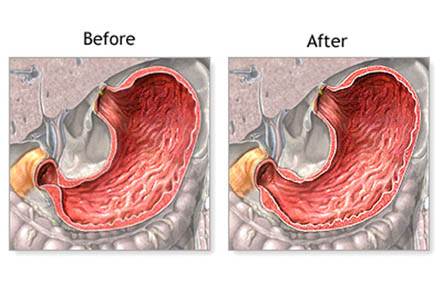Hypertrophic Pyloric Stenosis
Introduction
Pyloric stenosis is a condition which that may affect the gastrointestinal tract during infancy. It can cause the baby to vomit forcefully and often cause other problems such as dehydration and salt and fluid imbalance. Immediate treatment of this disorder is very important for the baby.
Pyloric stenosis is a narrowing of the pylorus or the lower part of the stomach through which food and other stomach contents pass to the small intestine. This pyloric stenosis is caused by enlargement of the muscles in the pylorus. As a result, the pyloric channel becomes narrowed to the point where food is prevented from emptying out of the stomach.
It is about four times more likely to occur in firstborn male infants and also has been shown to run in families. If one of the parents had pyloric stenosis, then an infant has about 20% risk of developing it.
Causes
It is believed that the pyloric stenosis is not present since birth, but the progressive thickening of the pylorus occurs after birth. It is not known exactly what causes the thickening of the muscles of the pylorus.
Iranian specialists have made remarkable achievements in infants' surgeries and Iran is among few countries that have gained access to the latest surgical technologies

Signs and Symptoms
Symptoms of pyloric stenosis generally begin around 3 weeks of age. They include:
1. Vomiting. The first symptom of pyloric stenosis is usually vomiting. The breast milk or formula is ejected forcefully from the mouth, in an arc, sometimes over a distance of several feet. This type of projectile vomiting usually takes place soon after the feeding, although in some cases it may be delayed for hours. Despite vomiting, a baby with pyloric stenosis is hungry again soon after vomiting and will want to eat.
2. Changes in stools. Babies with pyloric stenosis usually have fewer, smaller stools as very little or no food is reaching the intestines. Constipation or stools containing mucus may also be symptoms.
3. Failure to gain weight and lethargy. Most babies with pyloric stenosis will fail to gain weight or will lose weight. Over days, they are at risk for developing fluid and salt abnormalities and becoming dehydrated.
4. Dehydrated infants appear less active than usual, and they may develop a sunken “soft spot” on their heads, sunken eyes, and wrinkling of skin.
5. After feeds, increased stomach contractions may make noticeable ripples, or waves of peristalsis. These waves move from left to right over the baby’s belly as the stomach struggles to empty itself against the thickened pylorus.
Diagnosis and Treatment
The most important part of diagnosis in pyloric stenosis is a reliable and consistent history and description of the vomiting. The baby will be examined, and any weight loss or failure to maintain growth since birth will be noted. During the exam, the doctor may check for a lump in the abdomen which is usually firm and movable and feels like an olive.
If pyloric stenosis is suspected, an ultrasound of the baby’s abdomen is usually ordered. A barium swallow may be performed. In this test, the baby swallows a small amount of a chalky liquid (barium), and then special X-rays are taken to view the pyloric region for thickening. Blood tests are indicated as the continuous vomiting of stomach acid, as well as the dehydration, can cause salt and other imbalances in the blood that need to be corrected.
After diagnosis, the baby will be admitted to the hospital and prepared for surgery. Any dehydration or electrolyte problems in the blood are corrected with intravenous (IV) fluids, usually within 24 hours.
A surgical procedure called pyloromyotomy is a treatment for this condition. This involves cutting through the thickened muscles of the pylorus which relieves the blockage due to pyloric stenosis.
The surgery can also be performed through laparascopy by using a telescope like tiny camera and other small instruments inserted through multiple small incisions in abdomen.
Most babies are able to return to normal feedings fairly quickly, usually within 3 to 4 hours after the surgery. Some vomiting is normal for a day or so after surgery.
If you are breastfeeding, the hospital usually provides with a breast pump and assists in its use so that milk can be expressed until the baby can once again feed regularly.
Most babies are able to return to normal feedings fairly quickly, usually within 3 to 4 hours after the surgery.
The doctor will probably want to examine the child at a follow-up appointment to make sure the surgical site is healing properly and the baby is feeding well and maintaining or gaining weight.
Pyloric stenosis does not recur after a complete pyloromyotomy. If the symptoms persist for weeks after the surgery, it may suggest another medical problem or failure of surgery.